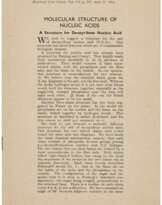ID 1032778
Lot 126 | The template of genetic replication
Estimate value
$ 10 000 – 15 000
"Until now, however, no evidence has been presented to show how [DNA] might carry out the essential operation required of a genetic material, that of exact self-duplication."
Very rare May offprint in which Watson & Crick explore the profound implications of the double-helix structure of DNA. The 25 April 1953 paper that identified the double helix structure had ended with a teaser: "It has not escaped our notice that the specific pairing we have postulated immediately suggests a possible copying mechanism for the genetic material." Their 30 May 1953 follow-up sought to explain the chemical mechanism by which cells pass on their character accurately. "Genetical implications" begins by acknowledging that the importance of DNA within living cells is "undisputed," noting that "[m]any lines of evidence indicate that it is the carrier of a part of (if not all) the genetic specificity of the chromosomes and thus of the gene itself. Until now, however, no evidence has been presented to show how it might carry out the essential operation required of a genetic material, that of exact self-duplication." The publication of Watson & Crick's papers in the April and May issues of Nature together revolutionized biochemistry and the other life sciences, and profoundly affected the study of molecular biology.
This article is much rarer as an offprint than the April papers. The last (and only) copy we trace selling at auction was in 2004; that one was signed by Peter Pauling. This copy belonged to Dr. Leonard Hamilton of Sloan-Kettering Institute of New York. Hamilton was a Cambridge-educated biochemist, just a few years younger than Francis Crick and Maurice Wilkins, with whom he was close friends. It was Hamilton who supplied the DNA specimens for Wilkins' lab to photograph. Wilkins wrote an excited letter to Hamilton on 20 March 1953, a month before the publication of this article, calling his specimens, "bloody good stuff" that gave "crystalline pictures!"
Octavo (209 x 139mm). 6 pp, 5 text illustrations including the double helix and its chemical formula. Self wrapper, with the last leaf tipped at left edge onto preceding page as issued. Provenance: Leonard D. Hamilton, 1921-2019 (ownership signature to front page).
| Artist: | Francis Crick (1916 - 2004) James Dewey Watson (1928) |
|---|---|
| Place of origin: | England, USA |
| Auction house category: | Printed books |
| Artist: | Francis Crick (1916 - 2004) James Dewey Watson (1928) |
|---|---|
| Place of origin: | England, USA |
| Auction house category: | Printed books |
| Address of auction |
CHRISTIE'S 20 Rockefeller Plaza 10020 New York USA | ||||||||||||||
|---|---|---|---|---|---|---|---|---|---|---|---|---|---|---|---|
| Preview |
| ||||||||||||||
| Phone | +1 212 636 2000 | ||||||||||||||
| Fax | +1 212 636 4930 | ||||||||||||||
| Conditions of purchase | Conditions of purchase | ||||||||||||||
| Shipping |
Postal service Courier service pickup by yourself | ||||||||||||||
| Payment methods |
Wire Transfer | ||||||||||||||
| Business hours | Business hours
|









